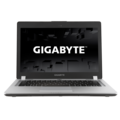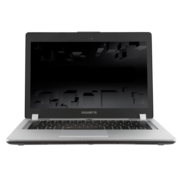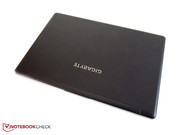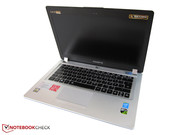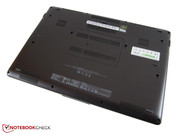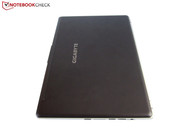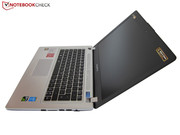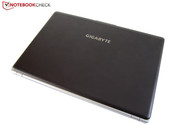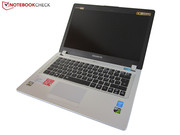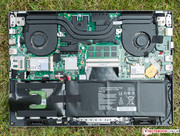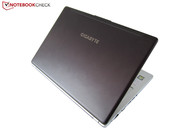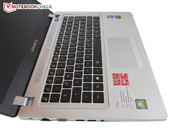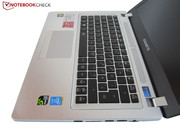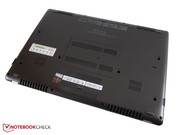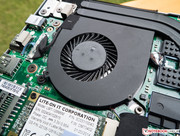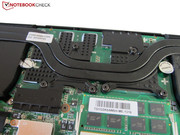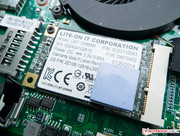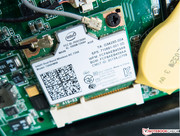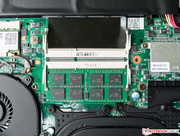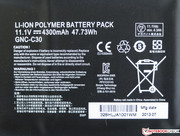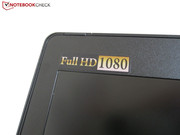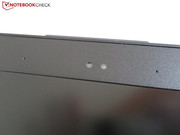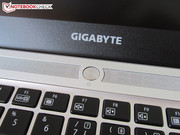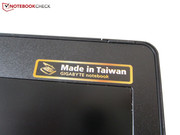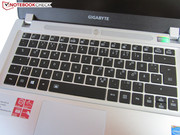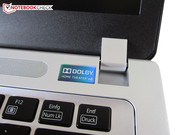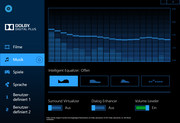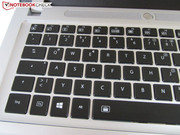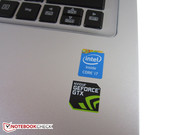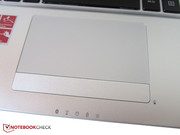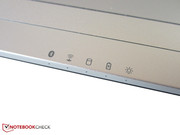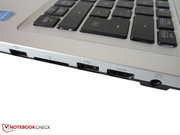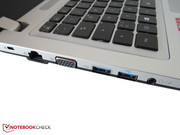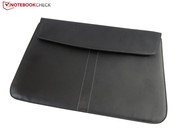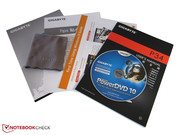Gigabyte P34G v2 Notebook Review

For the original German review, see here.
Just like the overall well-designed precursor, the new version of Gigabyte's P34G with an additional v2 in the name also has the potential to attract glances of awe. An Intel Core i7-4700HQ (4x 2.4 - 3.4 GHz, Hyper-Threading, TDP: 47 watts) alongside a high-performance Nvidia graphics card in a small, 14-inch and just over 2 cm high casing? Is that feasible or does the device have to be used with ear protection and on a fireproof surface? No, that is not necessary. Although our Speedy Gonzales does not keep as cool as the cartoon paragon, it does not have to hide from considerably larger gaming laptops either. It even has the advantage of a much higher mobility factor.
The review sample directly competes with the first comparison laptop, the 14-inch Razer Blade, which is based on the less power consuming and also slightly slower Intel Core i7-4702HQ (4x 2.2 - 3.2 GHz, Hyper-Threading, TDP: 37 watts), and Nvidia's GeForce GTX 765M from the generation prior to the current Maxwell chips. In contrast to the Gigabyte's IPS Full HD screen, the Razer Blade has to be satisfied with 1600x900 pixels and TN. Despite the same dimensions, it is even 4 mm thinner than the review sample. MSI provides the third device dubbed 2PE Ghost Pro 3K Edition (2PEWi716SR21) in this comparison round. Its 15.6-inch IPS screen stands out with a resolution of 2880x1620 pixels and is powered by the nominally fastest of the three processors with Intel's Core i7-4710HQ (4x 2.5 - 3.5 GHz, Hyper-Threading, TDP: 47 watts). The lightning-fast Nvidia GeForce GTX 870M is in charge of graphics calculations so that the 15-inch device has the highest performance potential of the three candidates. Despite its bigger size, MSI's laptop also only weighs a bit less than 2 kg and has a height of 2 cm. However, it is also the most expensive device at approximately 2000 Euros, ~$2720 (Gigabyte: approx. 1500 Euros, ~$2040; Razer Blade: approx. 1700 Euros, ~$2312).
Case
At first glance, it could be thought that MSI copied the stylish design of the MacBook Airs to a slight extent. In contrast to the casing's sleek, all-over plastic underside, Gigabyte opted for aluminum with either a silver or charcoal matte finish for the upper side. Unlike the dark version, the light-colored surface proves to be largely insensitive to fingerprints. The laptop is very elegant, but this impression is ruined when looking closer. A few irregularities are found in the build, for example, protruding edges on the sides and an imperfectly fitted keyboard tray. Not at all nice: The base's sides do not close flush with its upper side in the area of the ports. Not very trustworthy cracking noises are produced when both parts are pressed together here (which should actually not be possible). We cannot say that our review sample makes a solid impression. However, these problems were not ascertained in the precursor's identical casing. Thus, we have to give Gigabyte a poor grade in quality management in this single case but can hope that we are dealing with a "lemon device" in this test. But we have to rate what we actually find.
Like in the P34G (v1), the lightly submerged keyboard can be dented without much effort. The hinges make a better impression since they barely allow wobbling on jerky surfaces like in the car or on the train. The main vents are cleverly placed in the rear and are not covered during use on the lap. Image distortions are seen on the front when pressing around on the back of the rigid lid. Its maximum opening angle is exactly 135 degrees.
Connectivity
The laptop does not sport any modern interfaces, such as Thunderbolt or DisplayPort, and we have no idea why a VGA port should be installed in a gaming laptop. Two of the four USB ports still support the 2.0 standard, which does not quite match Gigabyte's price expectation. However, the Ethernet port is reasonable because dedicated, ping-keen users frequently do not like to rely on Wi-Fi. Since the waste heat is discharged from the rear, most ports have been positioned in the center of both sides where USB sticks and cords are not as obstructing as when in the very front.
Communication
Intel's dual-band Wireless-AC 7260 that also supports the less overrun 5 GHz band seems to be first choice for many manufacturers who want to equip their laptops with the newest IEEE 802.11 ac standard, also known as "Gigabit Wi-Fi." The precursor only sported Intel's Wireless-N 7260. Razer's Blade even features a Qualcomm Killer module specially made to meet the needs of gamers with extended configuration options.
Accessories and Software
Besides the power supply, there is also a DVD with the pre-loaded, full version of PowerDVD 10, a printed manual, warranty documents, and a big microfiber cloth in the box. There are no installation and recovery media. Courteously, Gigabyte includes a padded leatherette bag with a Velcro closure in line with the advertised mobility. The manufacturer does not offer other, specifically designed accessories for the P34G v2. We do want to mention the extremely convenient Gigabyte Smart Manager (screenshot) that enables accessing the most frequently used system settings from one menu. The setting Fan Tweak is also here and allows changing the fan mode to Stealth, Auto, or Turbo. We performed all benchmarks with the default setting Auto. The fans permanently run at full speed regardless of the load when Turbo is selected.
Maintenance
A maintenance cover secured with screws is located on the underside's center. However, it only allows accessing both RAM banks, one of which is empty. All else can first be accessed after removing the underside. That is not everyone's cup of tea and could affect the warranty. When all 14 screws are removed, the user can take delight in an excellent accessibility of all maintainable components - with the big exception of the battery that can only be reached from the inside and is screwed to the casing.
Warranty
The warranty period for laptops purchased in Germany is two years, but only one year is included on accessories such as the battery. Details can be found here.
Input Devices
Keyboard
It is not surprising that the keys of the chiclet keyboard only feature a low drop considering the slim build. The surface is even and slightly slip-proof, but it is not rubber coated. The tester found the pressure point a bit too spongy, but the soft stroke is favorable for longer typing sessions. The keyboard bed yields marginally under minor pressure on the keys. The quiet, yet somewhat clattering stroke noise alongside the imperfect stiffness does not convey a particularly high-quality impression.
The numerous special functions that can be accessed via the FN key and go beyond the ordinary were noted positively. The largely standard layout also does not give reason for complaint. The keys are big enough and are sufficiently spaced. We particularly liked the two-stage keyboard backlight that presented itself as bright and even.
Touchpad
In view of the available room, the absolutely sleek touchpad could certainly have featured a slightly bigger size. Both mouse keys share a single, solid bar that cannot be pressed in the center. Accuracy and responsiveness did not exhibit any irregularities, and even rapid movements were followed. There is an unusually wide area that no longer responds to touch at the input device's outer edge. In the tester's opinion, the resistance as well as the acoustic and tactile feedback of the mouse keys in conjunction with their short drop and crisp pressure point is virtually ideal. The relevant configuration options of the ELAN driver can be seen in both screenshots above.
Display
Most gaming laptops sport a TN screen, perhaps because the alternative IPS that Gigabyte opted for in the review sample is not exactly known for fast switching times. However, the P34G v2, of course, benefits from the advantages of the IPS technology, such as higher contrasts, better color accuracy, and the superior viewing-angle stability. The resolution of 1920x1080 pixels (16:9) distributed over 14-inches results in a very good pixel density of 157 ppi. The image sharpness is exemplary and facilitates reading the sometimes almost too small characters. No alternative screens are available.
The maximum brightness is not outstanding but acceptable. Both contenders used in this test have a lead of 20 and 34% on the P34G v2 here. An illumination of 85% is completely satisfactory. The subjective impression is not as good because faint light spots are seen on an absolutely dark image (RGB 0,0,0) but without the need to speak of screen bleeding.
| Gigabyte P34G v2 GeForce GTX 860M, 4700HQ, Liteonit LMT-128M6M | Razer Blade 14 inch GeForce GTX 765M, 4702HQ, Samsung SSD PM841 MZMTD128HAFV mSATA | MSI GS60 - 2PEWi716SR21 GeForce GTX 870M, 4710HQ, 2x Kingston RBU-SNS8100S3128GD (RAID 0) | |
|---|---|---|---|
| Display | -35% | 0% | |
| Display P3 Coverage (%) | 63.6 | 40.92 -36% | 64.7 2% |
| sRGB Coverage (%) | 90.3 | 60.6 -33% | 89.3 -1% |
| AdobeRGB 1998 Coverage (%) | 65 | 42.33 -35% | 64.7 0% |
| Screen | -53% | 1% | |
| Brightness middle (cd/m²) | 270 | 361 34% | 323 20% |
| Brightness (cd/m²) | 265 | 337 27% | 310 17% |
| Brightness Distribution (%) | 85 | 89 5% | 82 -4% |
| Black Level * (cd/m²) | 0.25 | 1 -300% | 0.43 -72% |
| Contrast (:1) | 1080 | 361 -67% | 751 -30% |
| Colorchecker dE 2000 * | 4.59 | 7.32 -59% | 3.25 29% |
| Greyscale dE 2000 * | 5.36 | 6.88 -28% | 3.1 42% |
| Gamma | 2.69 82% | 3.06 72% | 2.16 102% |
| CCT | 6859 95% | 7581 86% | 6054 107% |
| Color Space (Percent of AdobeRGB 1998) (%) | 58 | 38.17 -34% | 59 2% |
| Total Average (Program / Settings) | -44% /
-48% | 1% /
0% |
* ... smaller is better
| |||||||||||||||||||||||||
Brightness Distribution: 85 %
Center on Battery: 270 cd/m²
Contrast: 1080:1 (Black: 0.25 cd/m²)
ΔE ColorChecker Calman: 4.59 | ∀{0.5-29.43 Ø4.79}
ΔE Greyscale Calman: 5.36 | ∀{0.09-98 Ø5}
58% AdobeRGB 1998 (Argyll 1.6.3 3D)
65% AdobeRGB 1998 (Argyll 3D)
90.3% sRGB (Argyll 3D)
63.6% Display P3 (Argyll 3D)
Gamma: 2.69
CCT: 6859 K
The review sample's contrast, comprised of the black level and maximum brightness, achieves a top rate of 1080:1. The TN screen in Razer's Blade achieved a very poor black level of 1. The great maximum brightness does not help much here either. Both rates lead to a bad ratio of 361:1. MSI's GS60 places itself between both contenders in all previously mentioned single rates.
As for color accuracy, both IPS screens use their technological advantage and achieve good DeltaE rates of 5 (Gigabyte) and 3 (MSI), while Razer's Blade is the taillight with a still good DeltaE of 7. The gamma rate of the P34G v2 is 0.5 above the Windows target of 2.2. A 60% coverage of the, mainly relevant for (semi) professional image editing, large AdobeRGB color space is normal for IPS screens and approximately 40% for TN screens. All three devices in the test range exactly within this field.
It is also interesting how the screen fares outdoors since the gaming laptop will occasionally be taken along on excursions. Although the maximum brightness is not high enough to speak of perfect legibility, its matte surface mostly allows for comfortable working when direct sunlight is avoided and the screen is not directly turned toward the sun.
The viewing-angle stability of our little gaming machine does a good, but not outstanding job for IPS conditions. A slightly milky image impression alongside reduced contrasts and a deviated color reproduction is noticed when the screen is looked at from a simultaneous horizontally and vertically shifted point. This phenomenon can be easily avoided in real-life use because the reproduction is beyond reproach when the viewing angle is only shifted on one axis.
Performance
The installed Intel Core i7-4700HQ (4x 2.4 - 3.4 GHz, Hyper-Threading, TDP: 47 watts) is actually suitable for laptops with a size of at least 15-inches considering its relatively high TDP. It is supported by 8 GB of RAM that operates in single-channel mode. There is also one empty memory bank for upgrading. On its own, the CPU's performance enables running almost all commercially available programs up to highly parallelized software for 3D rendering lag-free. The calculations of the latter can often be moved to the strong Nvidia GeForce GTX 860M via Nvidia's CUDA interface. The GPU has a dedicated 4 GB GDDR5 RAM, which is enough to smoothly render most up-to-date and graphically complex games in high, but not ultra, settings.
Processor
All CPUs from Intel's current Haswell generation are built in a 22 nm process. However, unlike the virtually identical i7-4700MQ (4x 2.4 - 3.4 GHz, Hyper-Threading, TDP: 47 watts), the i7-4700HQ is soldered to the motherboard. The maximum clock that can be achieved when one core is loaded is 3.4 GHz. It is 3.3 GHz on two cores and 3.2 GHz when all four are loaded. The base clock is 2.4 GHz. Up to eight threads can theoretically be processed simultaneously via Hyper-Threading. In contrast to its i7-3630QM counterpart from the former Ivy Bridge generation, the per-MHz performance has been increased by roughly 10%. The CPU-integrated very frugal Intel HD 4600 GPU manages 2D graphics calculations. More demanding tasks, such as the tested games, are automatically performed on the GeForce GTX 860M, owing to Nvidia's Optimus technology.
We again use Cinebench R11.5 to assess the CPU's pure performance, which does not really reveal any surprises. The scores of similarly strong processors, on paper, are close to each other in both the multi-core and in single-core benchmarks, and the review sample's performance is as expected compared with other laptops that sport the same CPU. The quad-core Turbo is used ideally in this test. However, that does not apply to battery mode where the P34G v2 does not surpass 1.3 GHz.
| Cinebench R11.5 | |
| CPU Multi 64Bit (sort by value) | |
| Gigabyte P34G v2 | |
| Razer Blade 14 inch | |
| MSI GS60 - 2PEWi716SR21 | |
| Gigabyte P34G | |
| CPU Single 64Bit (sort by value) | |
| Gigabyte P34G v2 | |
| Razer Blade 14 inch | |
| MSI GS60 - 2PEWi716SR21 | |
| Gigabyte P34G | |
System Performance
The system performance that we ascertain using PCMark 7, among others, is still on the expected level, but with minor limitations. In addition to the CPU performance, the scores also include storage device and graphics performance with a different weighting depending on the single test. Unsurprisingly, MSI's GS60 that sports the swiftest hardware in this test achieves the best total rating. However, we cannot explain why the first version of the P34G, which is largely identical with the P34G v2 excepting for the slower GPU, always outperforms our review sample by 10 to 15%. Generally, the review sample falters very slightly in PCMark 7 despite its in total very good scores. However, this is not significant for real-life use that is characterized by lightning-fast operation.
| PCMark 7 Score | 5400 points | |
| PCMark 8 Home Score Accelerated v2 | 3362 points | |
| PCMark 8 Creative Score Accelerated v2 | 4079 points | |
| PCMark 8 Work Score Accelerated v2 | 4233 points | |
Help | ||
Storage Devices
Both Gigabyte's P34G v2 and Razer's Blade are on par with an excellent, virtually identical performance in all single read tests of the AS SSD benchmark. However, the GS60 quickly outperforms them with its RAID 0 array of two 128 GB SSDs sometimes. Since the access times of SSDs do not benefit from these kinds of RAIDs, the advantage in the 4k test is logically the lowest, while it is not less than 72% in sequential read. This might throughout be noticed in real-life when games read large amounts of data "in bulk." As to the write speed (Write Score), our Gigabyte proves to be clearly superior with a plus of 37 and 62% respectively.
| Gigabyte P34G v2 GeForce GTX 860M, 4700HQ, Liteonit LMT-128M6M | Razer Blade 14 inch GeForce GTX 765M, 4702HQ, Samsung SSD PM841 MZMTD128HAFV mSATA | MSI GS60 - 2PEWi716SR21 GeForce GTX 870M, 4710HQ, 2x Kingston RBU-SNS8100S3128GD (RAID 0) | |
|---|---|---|---|
| AS SSD | -12% | 19% | |
| Seq Read (MB/s) | 497.5 | 510 3% | 854 72% |
| 4K Read (MB/s) | 27.9 | 28.06 1% | 30.61 10% |
| 4K-64 Read (MB/s) | 295.9 | 294.7 0% | 358 21% |
| Score Read (Points) | 374 | 374 0% | 474 27% |
| Score Write (Points) | 345 | 132 -62% | 217 -37% |
Graphics Card
The GeForce GTX 860M is an offspring from Nvidia's Maxwell generation introduced in March 2014. The GM107 chip is built in the 28 nm process and fuses a maximum of 4 GB of GDDR5 RAM via a 128-bit bus. Owing to wider buses and more execution units, the faster GTX 870M (192-bit, GK104) and GTX 880M (256-bit, GK 104) achieve considerably higher memory bandwidths. The GTX 860M compensates for that to a small extent with higher clock rates.
| Gigabyte P34G v2 GeForce GTX 860M, 4700HQ, Liteonit LMT-128M6M | Razer Blade 14 inch GeForce GTX 765M, 4702HQ, Samsung SSD PM841 MZMTD128HAFV mSATA | MSI GS60 - 2PEWi716SR21 GeForce GTX 870M, 4710HQ, 2x Kingston RBU-SNS8100S3128GD (RAID 0) | |
|---|---|---|---|
| 3DMark | -27% | 8% | |
| 1920x1080 Fire Strike Score (Points) | 3790 | 2249 -41% | 4294 13% |
| 1920x1080 Fire Strike Graphics (Points) | 4051 | 2397 -41% | 4687 16% |
| 1920x1080 Fire Strike Physics (Points) | 8852 | 8186 -8% | 9031 2% |
| 1280x720 Cloud Gate Standard Score (Points) | 15963 | 11874 -26% | 16697 5% |
| 1280x720 Cloud Gate Standard Graphics (Points) | 28586 | 17033 -40% | 30343 6% |
| 1280x720 Cloud Gate Standard Physics (Points) | 6271 | 5764 -8% | 6487 3% |
| 3DMark 11 | -11% | 33% | |
| 1280x720 Performance (Points) | 5134 | 4028 -22% | 7089 38% |
| 1280x720 Performance GPU (Points) | 4902 | 3891 -21% | 7129 45% |
| 1280x720 Performance Physics (Points) | 6732 | 7394 10% | 7897 17% |
| Total Average (Program / Settings) | -19% /
-22% | 21% /
16% |
| 3DMark 11 Performance | 5134 points | |
| 3DMark Cloud Gate Standard Score | 15963 points | |
| 3DMark Fire Strike Score | 3790 points | |
Help | ||
Gaming Performance
Owing to the improved efficiency, the 860M can smoothly display most of the current and graphically intricate games in high settings. Some titles, such as BioShock Infinite, Tomb Raider (both 2013) and the red-hot Wolfenstein: The New Order can even be played in ultra. Compared with other laptops with the same graphics card, the P34G places itself at the top with a slight advantage. We did not ascertain GPU throttling even after an hour of full load using Prime95 and FurMark.
| low | med. | high | ultra | |
|---|---|---|---|---|
| Batman: Arkham City (2011) | 185 | 164 | 114 | 61 |
| Anno 2070 (2011) | 178.3 | 137.4 | 94.2 | 44.1 |
| Call of Duty: Black Ops 2 (2012) | 187 | 152.4 | 100.6 | 66.4 |
| Hitman: Absolution (2012) | 71.5 | 69 | 47.9 | 24.6 |
| Crysis 3 (2013) | 78.2 | 52 | 19.4 | |
| Tomb Raider (2013) | 315.9 | 166.4 | 100.1 | 45.9 |
| BioShock Infinite (2013) | 185.9 | 129 | 114.1 | 44.14 |
| Company of Heroes 2 (2013) | 50.8 | 48.54 | 34.51 | 14.6 |
| Battlefield 4 (2013) | 143.5 | 107.7 | 77 | 31.5 |
| Thief (2014) | 56.9 | 50.1 | 44.8 | 25.4 |
| Wolfenstein: The New Order (2014) | 59.9 | 59.1 | 45.4 | 35.2 |
Emissions
System Noise
A compact and slim casing usually involves using a small fan that needs high speeds to do its job. High speeds usually lead to high-pitched, penetrating fan noises during load. We did not observe this problem in our review sample. Gigabyte opted for separate fans for the graphics card and CPU that are located on the left and right in the casing. The device mostly ran without noise when idling (minimum). Sometimes, the CPU's fan sped up to the first level without evident reason and was immediately very audible. The fans often sporadically varied their speeds during higher, not quite consistent load like gaming, which was also slightly too coarse for our taste. The loud noise during full load included a high-pitched hum that might annoy younger gamers a bit. The middle-aged tester did not have problems with it. Like the P34G v2, the comparison devices reach a noise level of approximately 50 dB. Only Razer's Blade is a bit quieter than both contenders in idle average and idle maximum states.
Noise level
| Idle |
| 29 / 34.8 / 38.6 dB(A) |
| HDD |
| 30.9 dB(A) |
| Load |
| 45 / 50 dB(A) |
 | ||
30 dB silent 40 dB(A) audible 50 dB(A) loud |
||
min: | ||
Temperature
As can be seen in the chart below, we only recorded concerning temperatures near 60 °C on the underside when the system was loaded. That can get uncomfortable on the lap. However, the user will usually only have contact with the wrist rest for a longer time when the device is placed on a table and that does not even reach body temperature. In any case, both Gigabyte's P34G v2 and Razer's Blade are far remote from the hellfire (78 °C) that MSI's GS60 sparks during full load.
Our stress test with Prime95 + Furmark revealed a minor CPU throttling. The screenshot shows that approximately 4 minutes of permanent extreme load are necessary to trigger this effect, depending on the ambient temperature. The CPU reached almost troubling temperatures of up to 98 °C. Measurable and certainly noticeable limitations will not have to be expected even during intensive gaming under real-life conditions.
(-) The maximum temperature on the upper side is 50 °C / 122 F, compared to the average of 40.4 °C / 105 F, ranging from 21.2 to 68.8 °C for the class Gaming.
(-) The bottom heats up to a maximum of 58.5 °C / 137 F, compared to the average of 43.3 °C / 110 F
(±) In idle usage, the average temperature for the upper side is 36.1 °C / 97 F, compared to the device average of 33.9 °C / 93 F.
(±) The palmrests and touchpad can get very hot to the touch with a maximum of 36.3 °C / 97.3 F.
(-) The average temperature of the palmrest area of similar devices was 28.9 °C / 84 F (-7.4 °C / -13.3 F).
Speakers
The sound output via both front-sided speakers that radiate diagonally toward the surface is certainly not one of the review sample's strengths. The below average maximum volume is too low. The sound is treble-heavy, thin, slightly tinny (especially on a table) and does not provide significant dynamics or surround feel. The preloaded Dolby Home Theater with presets for music, movies, etc. cannot change much about that either. The frequently brutish sound in games suffers considerably under this so that we would recommend using headphones or external speakers for longer sessions.
Energy Management
Power Consumption
Progress: After Gigabyte's P34G (v1) treated itself to 0.5 watts even in a turned off state, the new model is satisfied with a still unnecessary 0.2 watts. The idle consumption is roughly on average with the few 14-inch gaming laptops. However, it has the highest consumption in this field under maximum load with 141.5 watts. The precursor was still happy with 113.5 watts. MSI's GS60 consumes as much as one-third more in every load state; Razer's Blade is consistently 17 to 25% more frugal.
| Off / Standby | |
| Idle | |
| Load |
|
Key:
min: | |
Battery Runtime
Although an identical battery is used as in the precursor, the runtime has improved considerably. In the Reader's test that measures the maximum idle runtime using minimum brightness and disabled consumers like Wi-Fi as much as 62% more is possible, and it is even 24% during load. Both comparison laptops lag behind this by approximately 33%. 124 minutes for the v2 oppose the 94 minutes of the old P34G during load. MSI is clearly defeated with only 36 minutes here. The Wi-Fi test is to simulate typical browsing behavior in a brightness dimmed to about 150 cd/m². Four-and-a-half hours is an impressive rate for a laptop based on such a strong CPU, and it leads our threesome. The potentially stronger GS60 understandably falls behind with a bit over three hours, and the slim Razer Blade places itself between them.
Verdict
Gigabyte regrettably prevents a better total rating due to the processing flaws of our review sample that were not ascertained in the precursor, and which do not fit to the target price range. The best things about the unstable keyboard are, in fact, the refined backlight and the many special functions. Apart from that, the P34G v2 is a well-designed, cleverly built gaming laptop, and the manufacturer still keeps control over thermals and noise production despite the compact size and low weight for this category. The laptop does not show any weakness in its most important field: gaming. Another highlight is the convincing IPS screen that is largely satisfying. We find it too bad that the performance of a laptop daring to straddle between mobility and power nosedives to such a high extent in battery mode.
Buyers looking for a 14-inch gaming laptop that allows playing current and coming-soon games smoothly and in an appealing quality is well-advised with the P34G v2, and generally also with Nvidia's GeForce GTX 860M. Razer's Blade is even a bit lighter and thinner but does not achieve the review sample's performance. The lower resolution is not as severe in view of the relatively small screen, but the budget TN screen is. In terms of build and impression, Razer's Blade outclasses our Gigabyte. Users who can live with 15.6-inches and want more power should look at MSI's GS60 2PE Ghost Pro 3K Edition (2PEWi716SR21); there are not many alternatives anyway. The unfortunately glossy 4k IPS screen, better sound, and the higher-quality casing speak for the GS 60. However, the thermal issues are a major drawback.




























